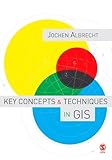Key concepts & techniques in GIS / Jochen Albrecht.
Material type: TextPublisher: Los Angeles : SAGE Publications, 2007Description: 1 online resource (116 pages) : illustrations, mapsContent type: text Media type: computer Carrier type: online resourceISBN: 9781849206518Other title: Key concepts and techniques in geographic information systemsSubject(s): Geographic information systemsGenre/Form: Electronic books.Additional physical formats: Print version:: Key concepts & techniques in GIS.DDC classification: 910.285 LOC classification: G70.212 | .A43 2007Online resources: Click to View
TextPublisher: Los Angeles : SAGE Publications, 2007Description: 1 online resource (116 pages) : illustrations, mapsContent type: text Media type: computer Carrier type: online resourceISBN: 9781849206518Other title: Key concepts and techniques in geographic information systemsSubject(s): Geographic information systemsGenre/Form: Electronic books.Additional physical formats: Print version:: Key concepts & techniques in GIS.DDC classification: 910.285 LOC classification: G70.212 | .A43 2007Online resources: Click to View Published in Thousand Oaks, Calif.
Includes bibliographical references (pages [95]-98) and index.
List of figures -- Preface -- 1. Creating digital data -- 1.1. Spatial data -- 1.2. Sampling -- 1.3. Remote sensing -- 1.4. Global positioning systems -- 1.5. Digitizing and scanning -- 1.6. The attribute component of geographic data -- 2. Accessing existing data -- 2.1. Data exchange -- 2.2 Conversion -- 2.3. Metadata -- 2.4. Matching geometries (projection and coordinate systems) -- 2.5. Geographic web services -- 3. Handling uncertainty -- 2.1. Spatial data quality -- 3.2. How to handle data quality issues -- 4. Spatial search -- 4.1. Simple spatial querying -- 5.2. Conditional querying -- 4.3. The query process -- 4.4. Selection -- 4.5. Background material : Boolean logic -- 5. Spatial relationships -- 5.1. Recoding -- 5.2. Relationships between measurements -- 5.3. Relationships between features -- 6. Combining spatial data -- 6.1. Overlay -- 6.2. Spatial Boolean logic -- 6.3. Buffers -- 6.4. Buffering in spatial search -- 6.5. Combining operations -- 6.6. Thiessen polygons --
7. Location-allocation -- 7.1. The best way -- 7.2. Gravity model -- 7.3. Location modeling -- 7.4. Allocation modeling -- 8. Map algebra -- 8.1. Raster GIS -- 8.2. Local functions -- 8.3. Focal functions -- 8.4. Zonal functions -- 8.5. Global functions -- 8.6. Map algebra scripts -- 9. Terrain modeling -- 9.1. Triangulated irregular networks (TINs) -- 9.2. Visibility analysis -- 9.3. Digital elevation and terrain models -- 9.4. Hydrological modeling -- 10. Spatial statistics -- 10.1. Geo-statistics -- 10.1.1 Inverse distance weighting -- 10.1.2. Global and local polynomials -- 10.1.3. Splines -- 10.1.4. Kriging -- 10.2. Spatial analysis -- 10.2.1. Geometric descriptors -- 10.2.2. Spatial patterns -- 10.2.3. The modifiable area unit problem (MAUP) -- 10.2.4. Geographic relationships -- 11. Geocomputation -- 11.1 Fuzzy reasoning -- 11.2. Neural networks -- 11.3. Genetic algorithms -- 11.4. Cellular automata -- 11.5. Agent-based modeling systems -- 12. Epilogue : Four-dimensional modeling -- Glossary -- References -- Index.
Description based on print version record.
Electronic reproduction. Ann Arbor, MI : ProQuest, 2015. Available via World Wide Web. Access may be limited to ProQuest affiliated libraries.


There are no comments on this title.